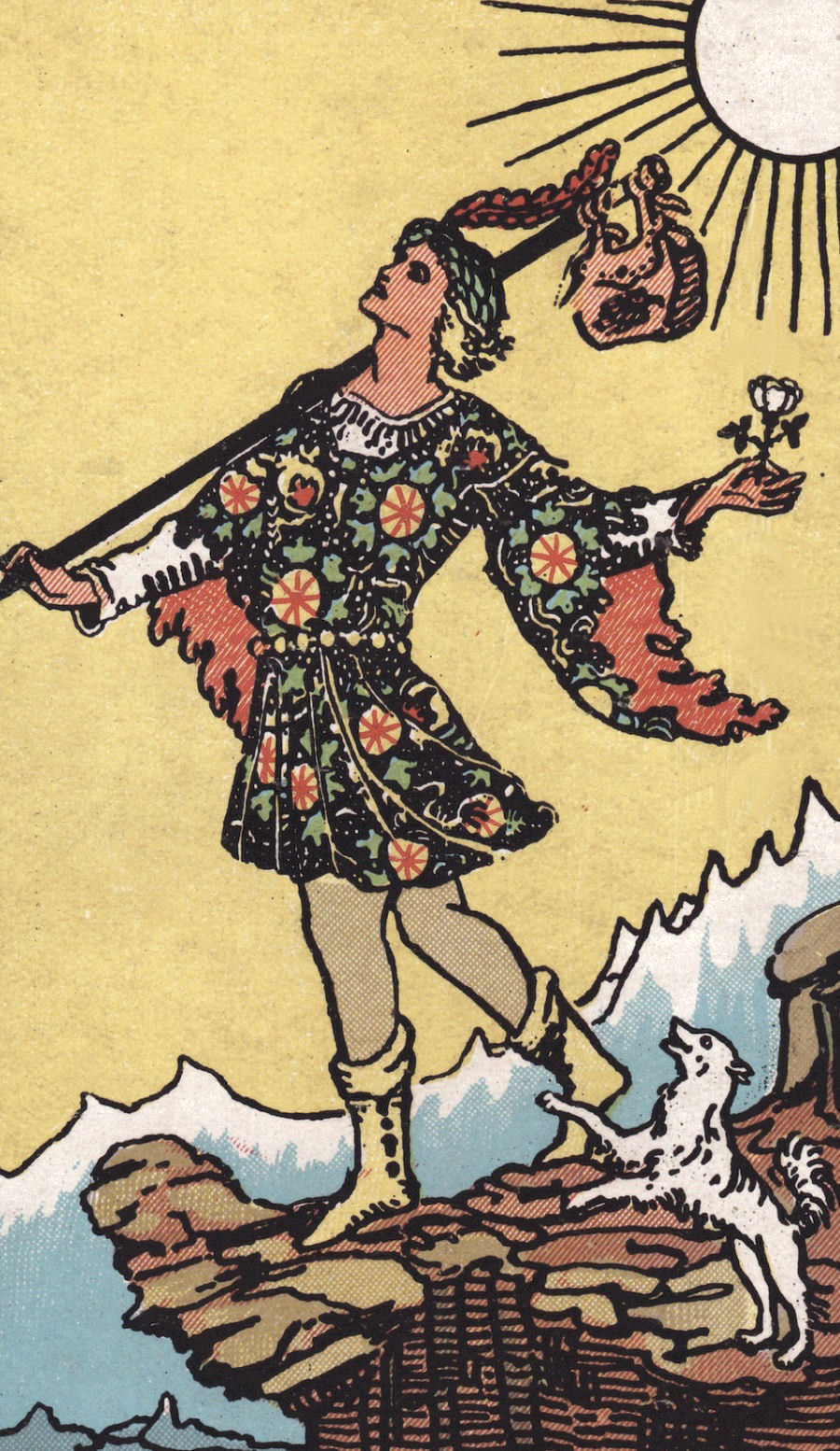Persistence of Memory Quake mod - Author's Insights
Unveiling the secrets of my psycho-liminal horror map...
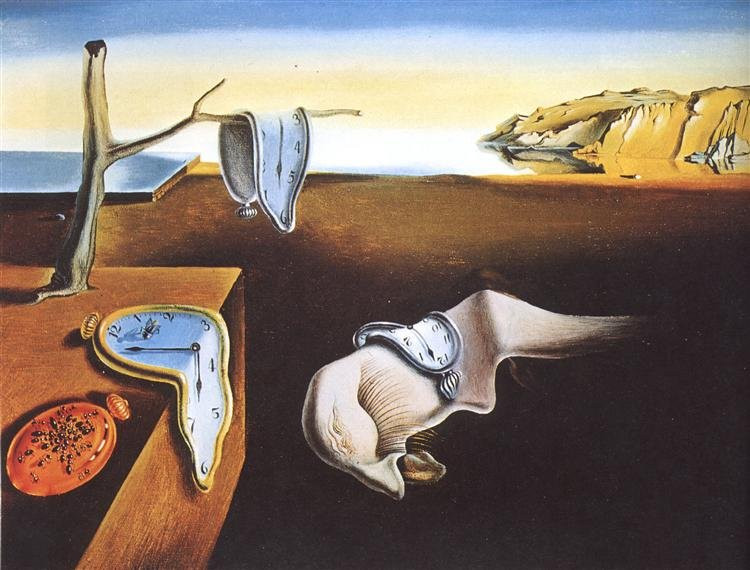
Download the masterpiece now!
(in Re:Mobilize mod's Re:Visions map jam)
Back to mapping
After 1.5 year spent on the first release of Re:Mobilize, both as a mapper and programmer/modder, I was exhausted and needed to rest during months (more than one year actually). What attracted me to the Re:Visions map jam in early 2025 was that enough time had passed and mapping had become something fresh again for me. Mostly, the theme was a very appealing challenge: transform a pre-existing deathmatch map into a singleplayer adventure. That was appealing to me not because of how EmeraldTiger envisioned the thing (taking advantage of the verticality often featured in deathmatch maps to implement Re:Mobilize movement-based tricks). No, what drew me to the party was the story it could tell.What would mean wandering in a deathmatch map, if you're a singleplayer? Exploring a nonsensical tortuous looping place where you're the only living creature around… A place with no exit. A never ending prison. And what if the convoluted design was an echo of a brain's convolutions? The prison would be a mental one. The result of a mindless ranger's life spent exploring similar places over and over again for 30 years since 1996, not only fighting to save his life but to find a bit of sense to it.
I started by checking all the vanilla deathmatch maps to figure out which one I'd want to revisit and it was love at first sight right away with DM1: Place of Two Deaths, so I hardly considered the other ones. The Elder World is where I feel at home the most, and the vanilla map's original name is highly symbolic, considering the ranger's duality which is largely exploited in my map's storytelling: the soldier vs the man, the man vs the child, the reality vs the illusion, the good karma vs the bad karma, etc.
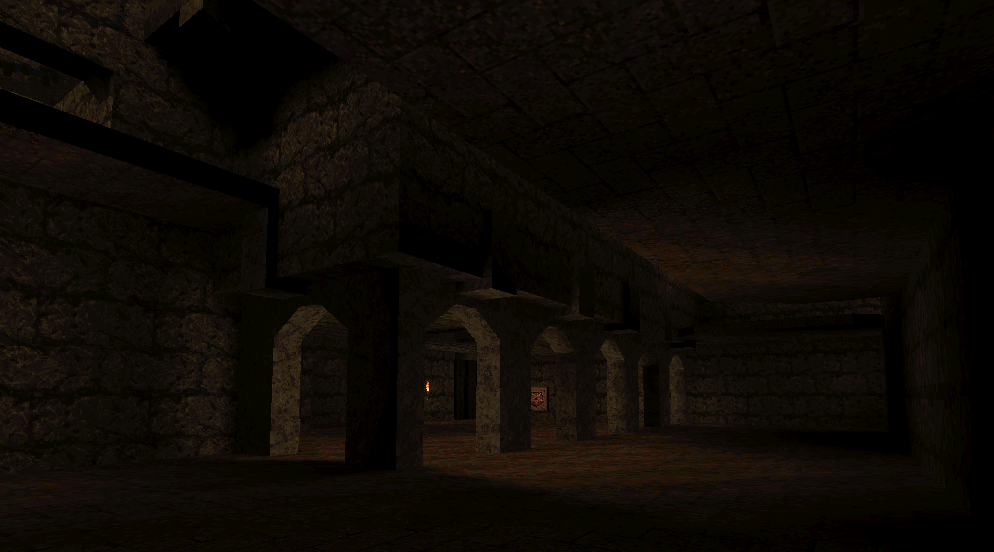
Original DM1: Place of Two Deaths by Tim Willits
Influences
As always with my works, this one is highly referential. After the Quake golden age honored in Church of the Unholy and the early horror literature of R.W. Chambers and H.P. Lovecraft forming the backbone of An Excursion to Carcosa, the main nods are more contemporary this time. The key sources of inspiration are MyHouse.wad and The Backrooms.
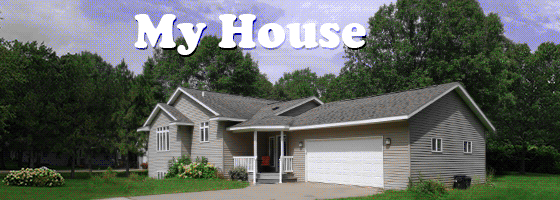
MyHouse.wad
The Backrooms
Map flow and story
In MyHouse.wad, the journey starts with the pretty mundane exploration of a familiar place which has not so much to offer, before things start becoming odd, then more and more obviously abnormal and uneasing, until it gets really scary. Following the same principle, you start Persistence of Memory in a setting which is well-known for 30 years: it's the almost untouched vanilla map made by Tim Willits at the time. The main divergence is that instead of sinister visuals (flayed bodies and faces) you get neutral alcoves with torches and a panel with the familiar sundagger pattern (plus, initially, the opening title of the map). Going around in circles in an empty map designed for several players when you happen to be alone quickly gets boring… Well, that's until (out of desperation) you end up taking the teleporter (because who knows, after all? it might lead somewhere else).That's the first key event in progression as it opens a loophole in your familiar reality. The next visit to the teleporter closet has a surprise in store for you: no more teleporter but a wine cave instead, with old fashion barrels on shelves and a cupboard filled with alcohol bottles. Is it still the good old reality or an other world? Or maybe a surfacing childhood memory? maybe at a time you lived in a house with a cellar? at a time alcohol was just one of the many adult things which were mysterious and forbidden?
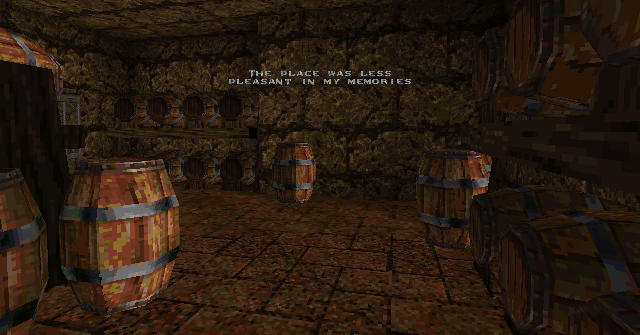
Double meaning at work.
Obviously when the player was there the last time (and all the times they had played DM1 before), the place was just a dull teleporter closet.
But working on the assumption that the place is a reminiscence of childhood already, could the centerprint message hint at the cellar having not been such a nice place for the ranger at the time? Wouldn't Daddy lock him there during hours? Don't the lowering bars look like a cell as much as a cellar…?
Once drunk, your perception of reality starts becoming less and less reliable, all the more that you're already on pills, as stated in the opening self-dialogue. You might notice small details here or there having changed… or was it really like that initially? Was this door here? Can a corridor be there?
Entering the impossible corridor and switching this weird non-Quake looking trigger is the second key event. When getting out, doubt is not permitted anymore: the place has definitely changed. Now Re:Mobilize gimmicks are all over the place. The exploration can restart from scratch with new rules. Once the player has seen all of it, it's time for a whole new layer of exploration… or introspection, I should say. A gate opens to the mirror world (which I may later refer to as the dreamworld, or even "Carcosa", as an echo to my previous map of that name, whose style inspired this one).
From that point the adventure becomes psychoanalytic. After having mindlessly circled around over and over in the previous parts of the map, it's time to ask oneself questions about the sense of all that, and the sense of life in general. Monsters won't show up at every corner, now you know it. So what? You're alone. Lost in this empty place. What's the point of all that? What's a ranger life? How do you become a ranger? Is it an inescapable destiny? Is there really no way out of this shit?
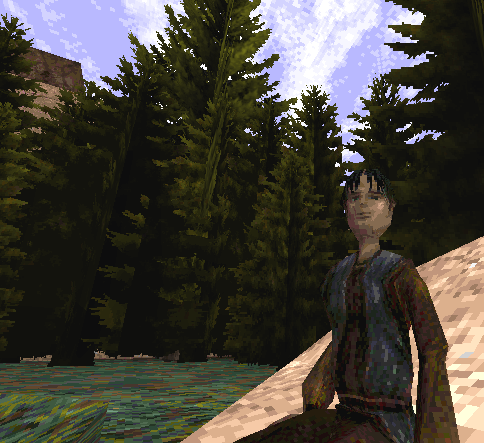
A quantum of solace
Meeting the boy in the forest unlocks the quest for runes which leads to the ending. Discovering the child room is bound to a parallel optional quest for items in order to open the chest. More on that below.
A quest for humanity
So the map is about the ranger's PTSD. His desperate life consisting of doing the same things over and over again: exploring nosensical abstract places, killing everything around without asking questions, until everything blends in his mind and he can't make the difference between reality and hallucinations. It's of course a meta-commentary on Quake: we play this game for years without really thinking of it, but what would it be being in this character's boots for good? Wouldn't it be the most awful life ever?Past a certain point, the ranger is not really able to trust his senses anymore and lives in a looping mental prison, not able to escape.
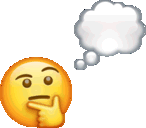
(I hope they won't read this and become mad at me; they are really dangerous with a grenade launcher!)
Speaking of the ranger, he has a decision to take: will he desperately embrace his deshumanizing fate and discard any shy remaining bind to his former humanity ? Or will he start a journey of self-rehumanization by giving care to the frightened child he was, and try to heal his mind?
Of course the first option is the one followed if killing the boy in the enchanted forest, which then turns withered. This mortal sin gives birth to a physical being representing all the past bad deeds and remorse about to pursue the player recklessly throughout the level (metaphorically for the rest of his now definitely cursed life). The runes needed to complete the adventure can still be grabbed but they are now defiled and have lost their beautiful golden color for a sad bitter purple tint. The ending ahead will seal the ranger's fate by showing he's become a totally insane murderer having slaughtered his own team. Despite it was a single player adventure, he ultimately played it deathmatch style (thus connecting back to the Re:Visions map jam theme, at a symbolic level).

From that point, abandon all hope of redemption…
The tarot symbols
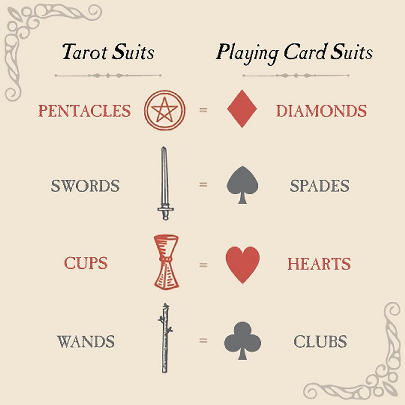
Suits equivalences
The usual playing cards we all know feature hearts, spades, diamonds and clubs. These are actually simplified and abstracted equivalents for the older cups, swords, pentacles and wands. The latter can be found on tarot games, especially the Rider-Waite game which is basically THE reference after which most of the other tarot games are designed.
Tarot is the subject of many specialized works largely exceeding the scope of this page, but the basic idea is that it's a tool to take distance and ask oneself the right questions about existence, life, difficult choices, and all kind of matters. All the cards are archetypes symbolizing this or that, and things become interesting when you relate them to a specific concern you may have.
You have a question, you draw a random card and now the magic consists in this intellectual play: what if this card would be the answer to your question? Since the card was drawn randomly, the "answer" it offers it totally random and, as such, likely doesn't correspond AT ALL at what you'd have expected. So it's up to you to endorse the task of extracting something meaningful out of a nonsensical "answer", by interpreting the card and figuring out what meaningful sense it could have relatively to the original question. It's a way of leaving your prejudices aside one minute, and trying to figure out the question in an unexpected way, out of your usual mental habits. That's an intellectual game of out-of-the-box thinking, and this can lead to extremely creative ways of approaching a problem (is it surprising that it's the kind of mindset required to complete my map?).
As you see, there's no real magic involved. It's a pure intellectual game, connected to thinking and intuition… Yet the answers you can find thanks to it can really bring actual solutions to real-life problems you have!
The interpretation of the cards is helped by a symbolic meaning associated to them. All those featured in Persistence of Memory were chosen for a reason, of course.
Here is the list of the symbols used in the map:
The card featured on the panel close to the spawn point represents the FOOL, a light-hearted wanderer naively starting a new journey, unaware of the adventures awaiting him. The ambiance text displayed when you shoot the panel is of course a pun on the card's name.
Strangely enough, in the original game the character is facing left instead of right, maybe to stress out how fool he is since, in our western minds, due to the direction of reading from left to right, left is associated with the past and right to the future. This guy is then starting his journey in the wrong direction. Even if Persistence of Memory makes him travel back in time indeed, that's for later. Initially the adventure is ahead in the future, so I reverted the card to better express that intention. It also keeps the panel from looking like a sign pointing towards the direction of the room with the pool of lava. This place is no more special than any other at that stage.
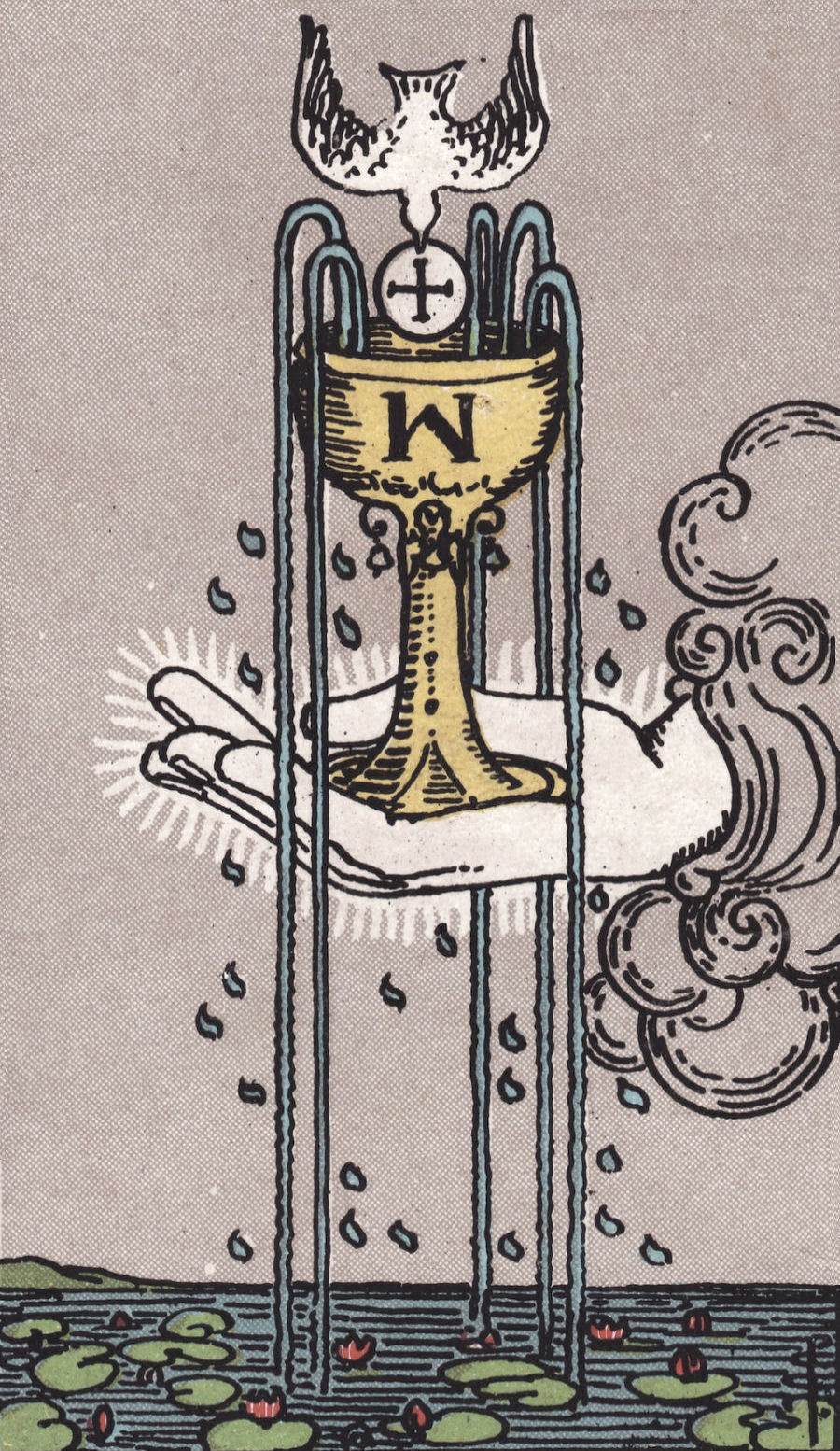
The ACE OF CUPS
(Click on the picture to enlarge)
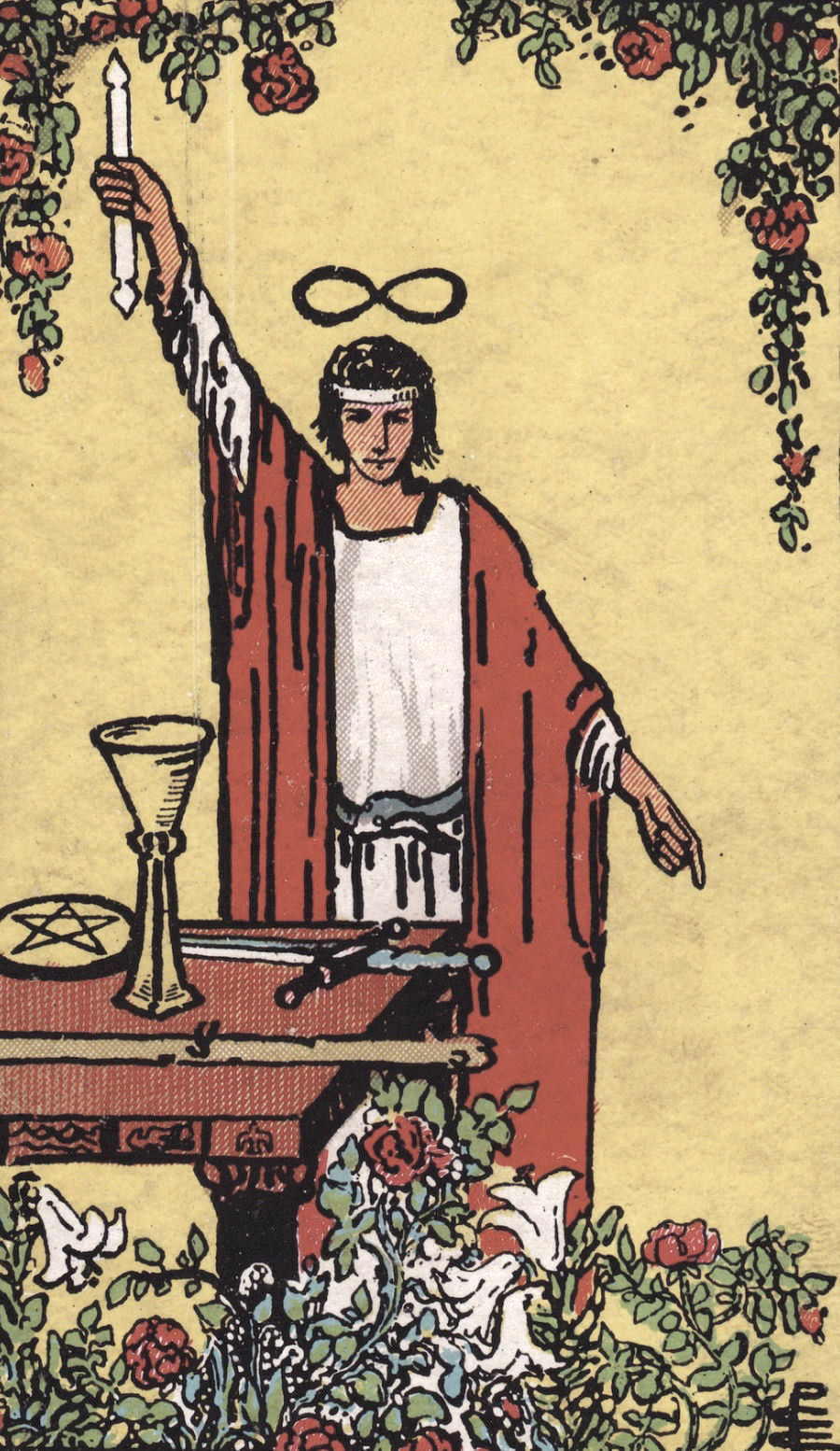
The MAGICIAN
(Click on the picture to enlarge)
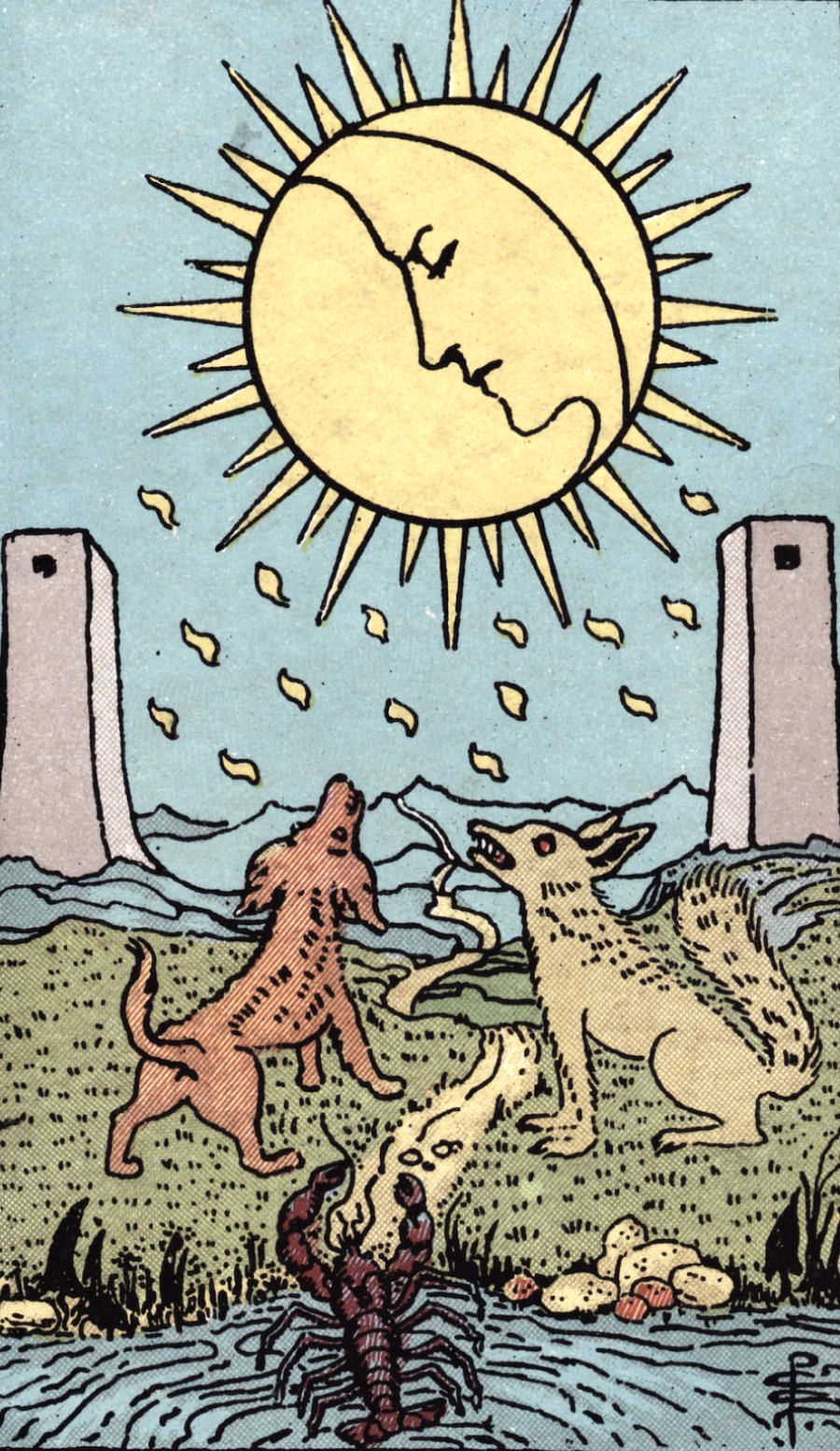
The MOON
(Click on the picture to enlarge)
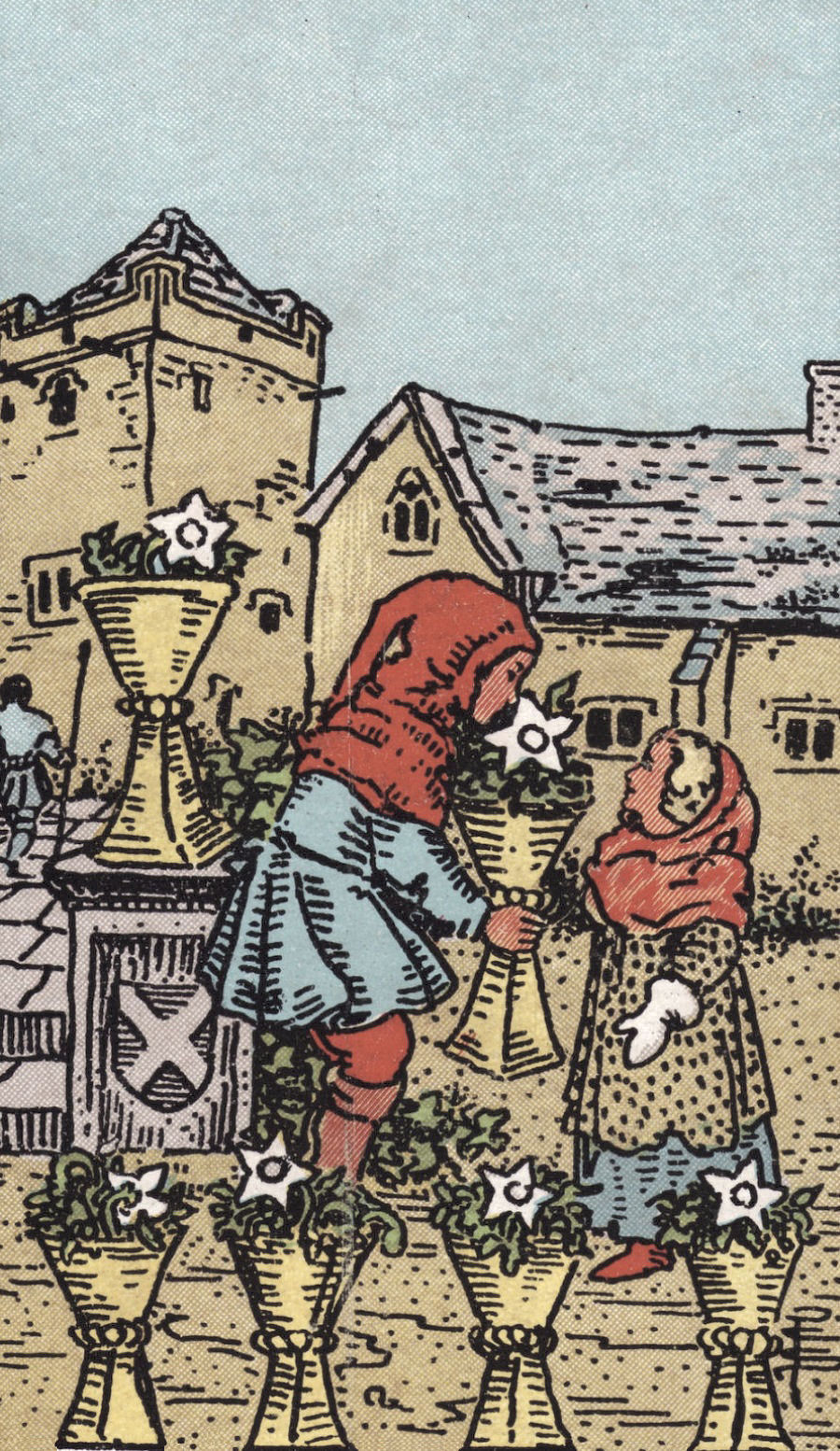
The 6 OF CUPS
(Click on the picture to enlarge)
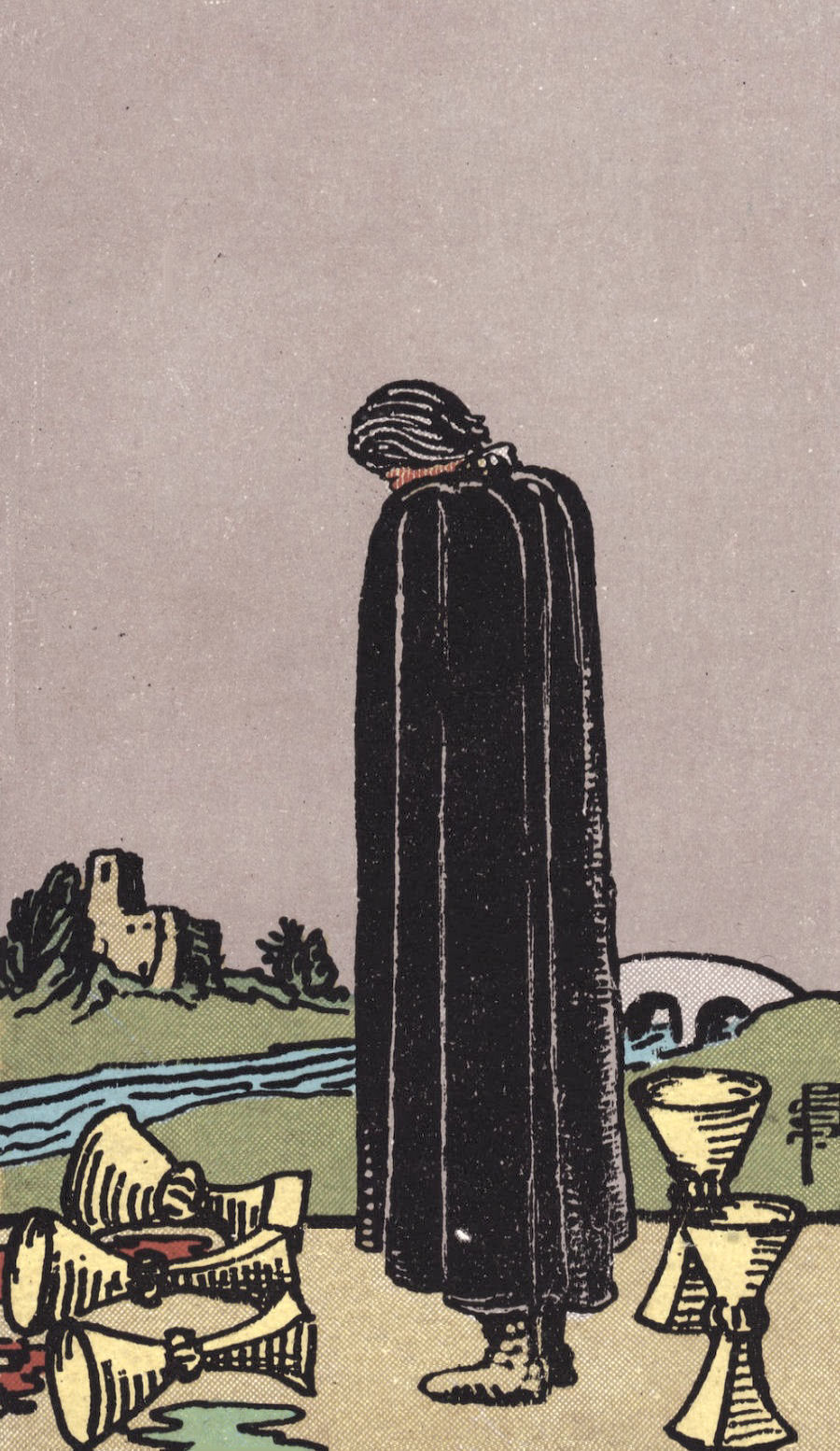
The 5 OF CUPS
(Click on the picture to enlarge)
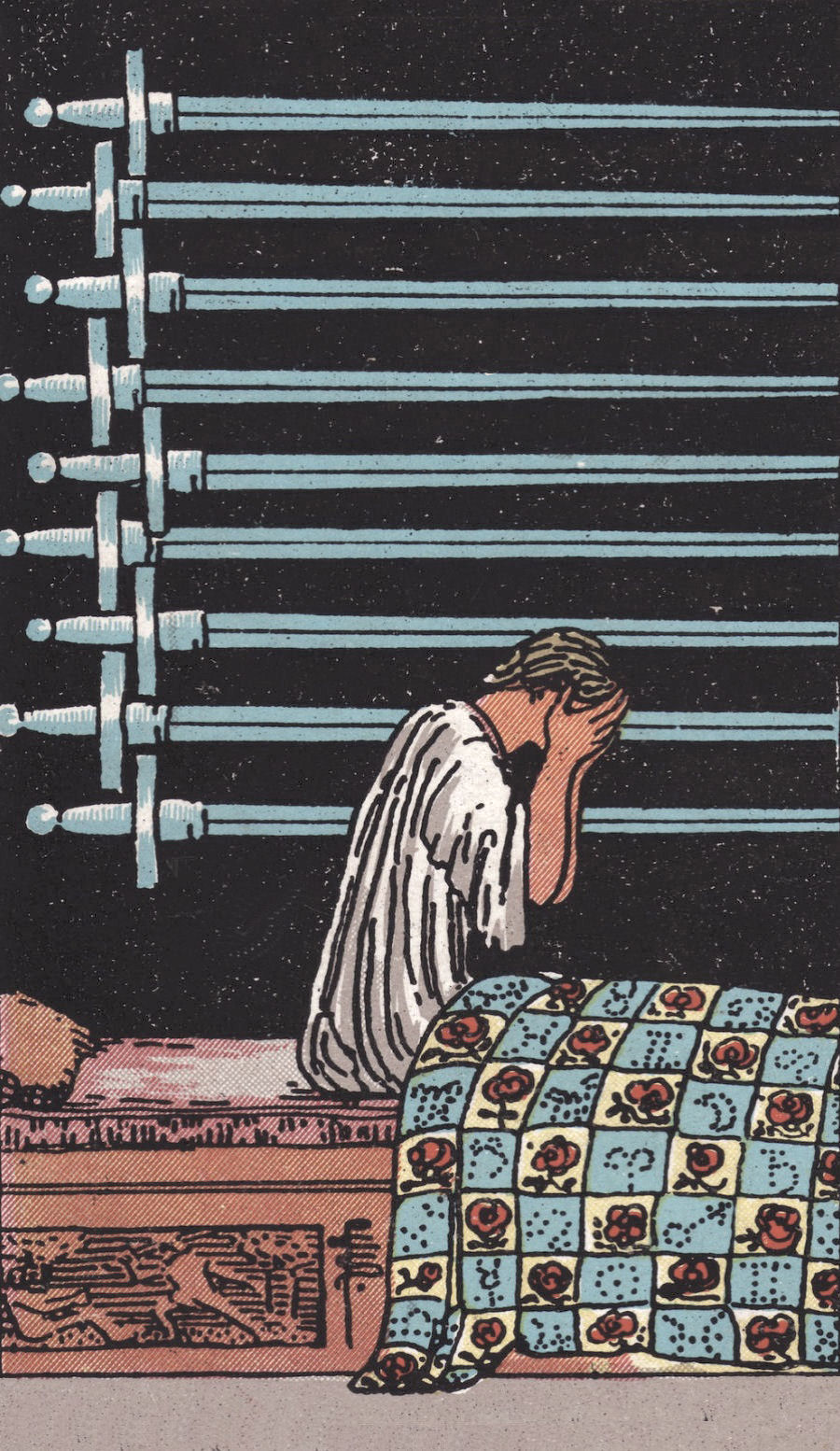
The 9 OF SWORDS
(Click on the picture to enlarge)
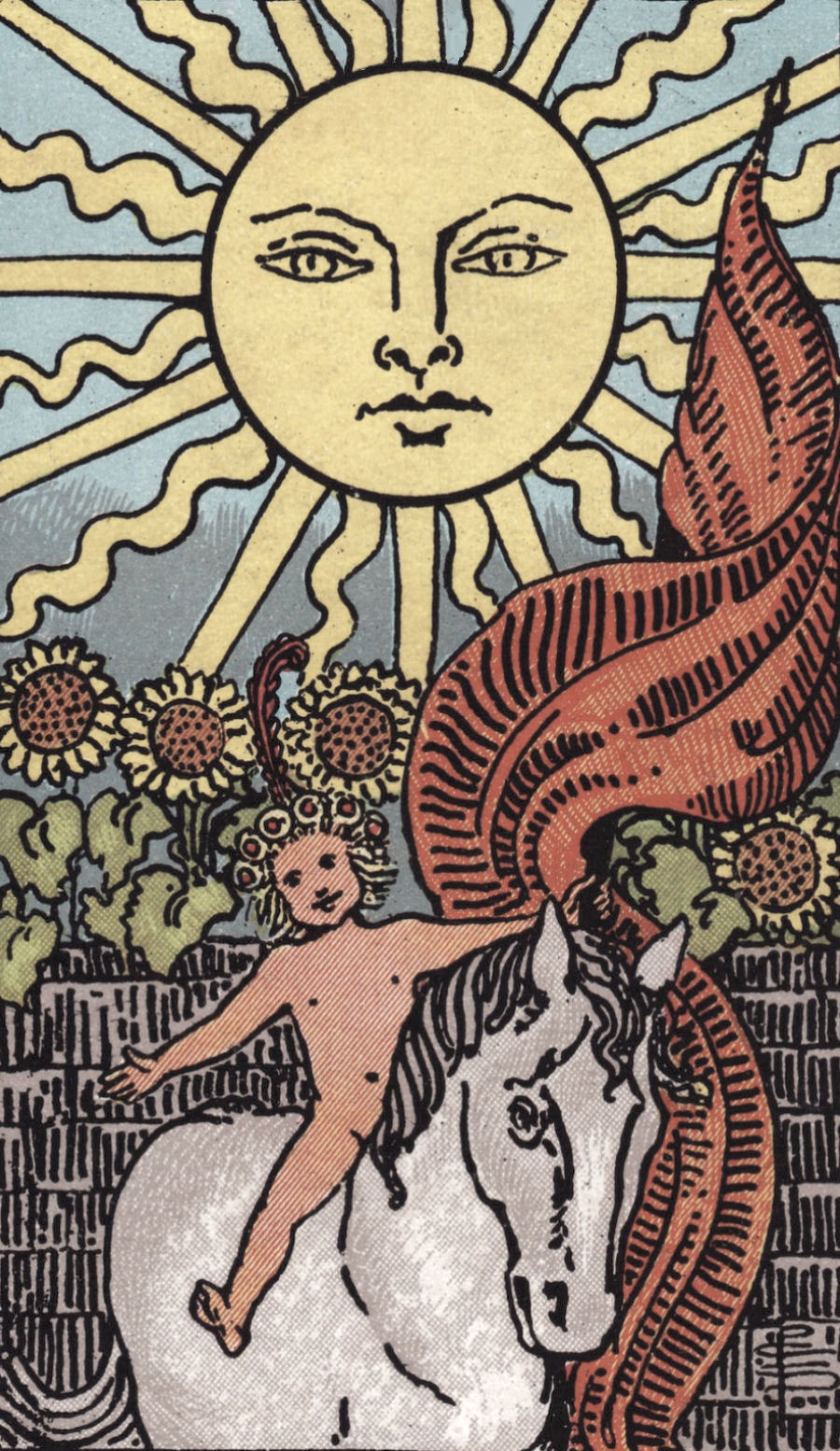
The SUN
(Click on the picture to enlarge)
- The CUP holds the emotions.
- The SWORD relates to the sharpness of intellect and language.
- The WAND expresses the desires moving us towards the action.
- The PENTACLE, with its round shape resembling a coin, stands for the down-to-earth satisfactions and material wellness.
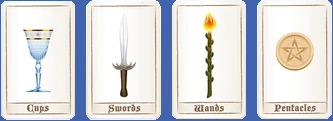
- The CUP could somehow be associated to intuition (in this context the intuition that already visited parts of the map may still hold surprises left for a later visit), even if its discovery may more likely be the result of the player having no idea where to go, and desperately resorting to random nonsensical actions!
- The SWORD, which as a weapon has obvious connections with violence, is discovered when smashing an armor.
- The WAND teases the player from above, like something you aim at without knowing how to reach it. It relates pretty well to the notion of "desire" and motivates the action of bouncing to reach it.
- The PENTACLE lies on the ground in a very pragmatic way. It's not only a puzzle item but also a useful artifact, well known of Quake players, far less abstract than the other three. It's also why it can be especially difficult for players to figure out this is the pentacle they are looking for. On a symbolic level, they have to re-unite the down-to-earth item to the spiritual quest going on.
Nods to MyHouse.wad
The most obvious nod is the mirror world soundtrack, the iconic memory=entryrrrr///// made by esselfortium for MyHouse. She nicely gave her authorization to use it for Persistence of Memory and is also the author of the peaceful Connect heard during the good ending.The map progression also comes straight out of MyHouse: an initially dull playground gradually reveals an unsuspected complexity, an increasing weirdness, more and more "impossible geometry" and creepiness, and involves passing through the looking glass at some point.
The childhood room is also an obvious reference, as it reproduces the atmosphere of the house by using the same textures, the same swinging doors, and their opening/closing sounds. The allusions to childhood are also a common theme, even if not exploited quite the same way. Also, I borrowed the plush models and the city carpet (which itself came from the Backrooms).
City carpet from Backrooms - Found Footage #3
Nods to The Backrooms
Well, the Backrooms area itself, to start with! You may "noclip out of reality" in the vaulted area close to the exit portal and end up in a recreation of the place. I'm really happy with this part of the map: I find it extremely well rendered and easily recognizable, even if the wallpaper I used is not the one made famous by the pre-existing Backrooms mythology. This wallpaper was lying on my hard drive for 23 years, waiting for the time I would eventually design a japanese themed Hexen II map. Believe it or not, this is an historical XVIIth century wallpaper pattern coming from the Katsura imperial villa located in Kyoto. It represents a stylized flower of pauwlonia. From an architectural wonder of the past times at the other end of the world, to a photograph in a specialized art book, and eventually to a Quake map… Things can sometimes travel weird journeys through space, time and realities.

Katsura imperial villa (1616-1658), fusuma panels with stylized pauwlonia flower pattern
(Doesn't it look like a Quake map? Isn't it already suggestive of Backrooms ahead of time?)
It's interesting that due to its awakening in the forest, this monster was seen by several players as "growing like a plant" or as a "weird black tree thing". Since I was focused on my "Backrooms reference" thing, I didn't expect that such an interpretation could be made, but it adds a whole new layer of symbolism and interpretation, so I'll certainly not complain about it. That's a sign that what I've cooked up is rich enough for other people to get to grips with it and elaborate their own extrapolations and theories. That's great!
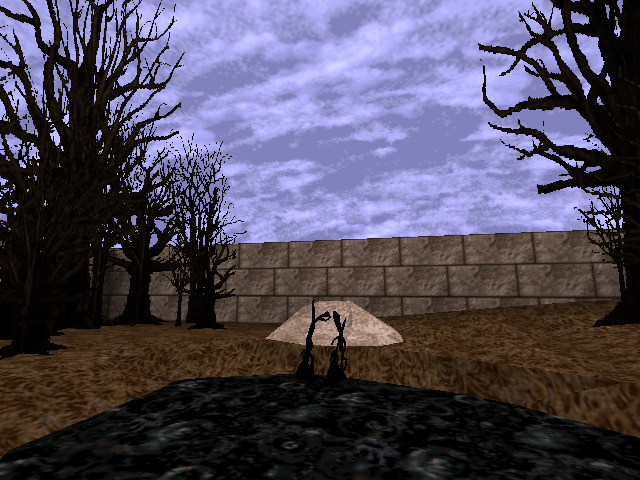
Growing weight of bad deeds…
Nods to my previous works
Project after project, I go on developing my own approach of mapping involving Hexen II gimmicks, heavy scripting and storytelling, and layers of references. I'm so happy to discover that my personal touch has drawn a few people's attention, and that they gladly go on following me despite the months (sometimes years) between two releases. Not being a complete unknown in the Quake community anymore, it become tempting to add a few winks to my previous works for the amusement of my most faithful followers.Church of the Unholy is referenced through the underground vaulted area near the exit portal: the brushwork comes straight from my first Quake map, of which it was the starting area instead. It very aptly evokes a medieval equivalent to the Backrooms, and that's how I got the idea of the area abruptly turning into the actual Backrooms (by means of a randomly timed teleportation), the layout of which is a hardly modified version (the main change is the lowered ceiling to increase the feeling of being weighed down).
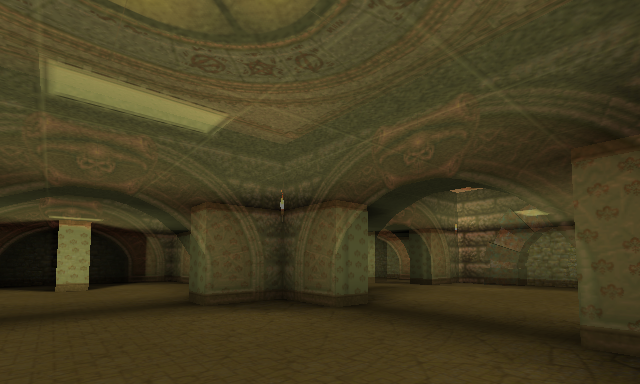
On the edge of coplanar realities…
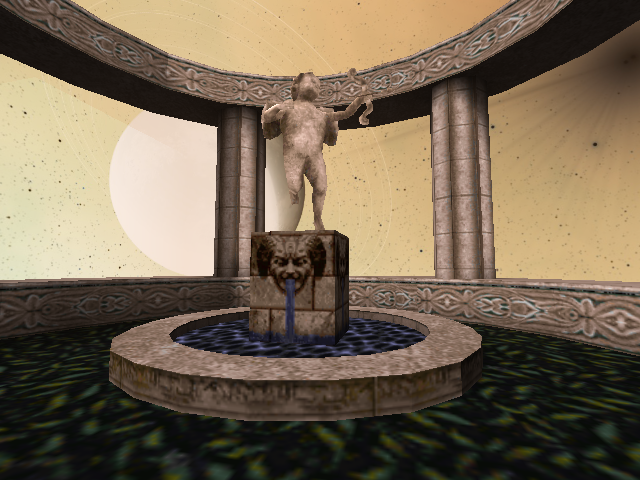
At the gardens of Carcosa
Paintings
It's hard to miss the prominence of paintings in the dreamworld. All are very famous and are related to the map's theming: oniric, morbid, unsettling… Yet they come in three flavors which serve distinct purposes.

Max Ernst, Garden Plane Trap (1935)
- Self-portrait (The Desperate Man) by Gustave Courbet
- The Nightmare by Johann Heinrich Füssli
- Garden Plane Trap by Max Ernst
- Guernica by Pablo Picasso
The second series consists in
- Persistence of Memory by Salvador Dali
- The Disintegration of the Persistence of Memory by Salvador Dali
- An untitled reinterpretation of Persistence of Memory made in the early 2020s by a real-life young 11/12 years old Londonian schoolgirl named Sahar.
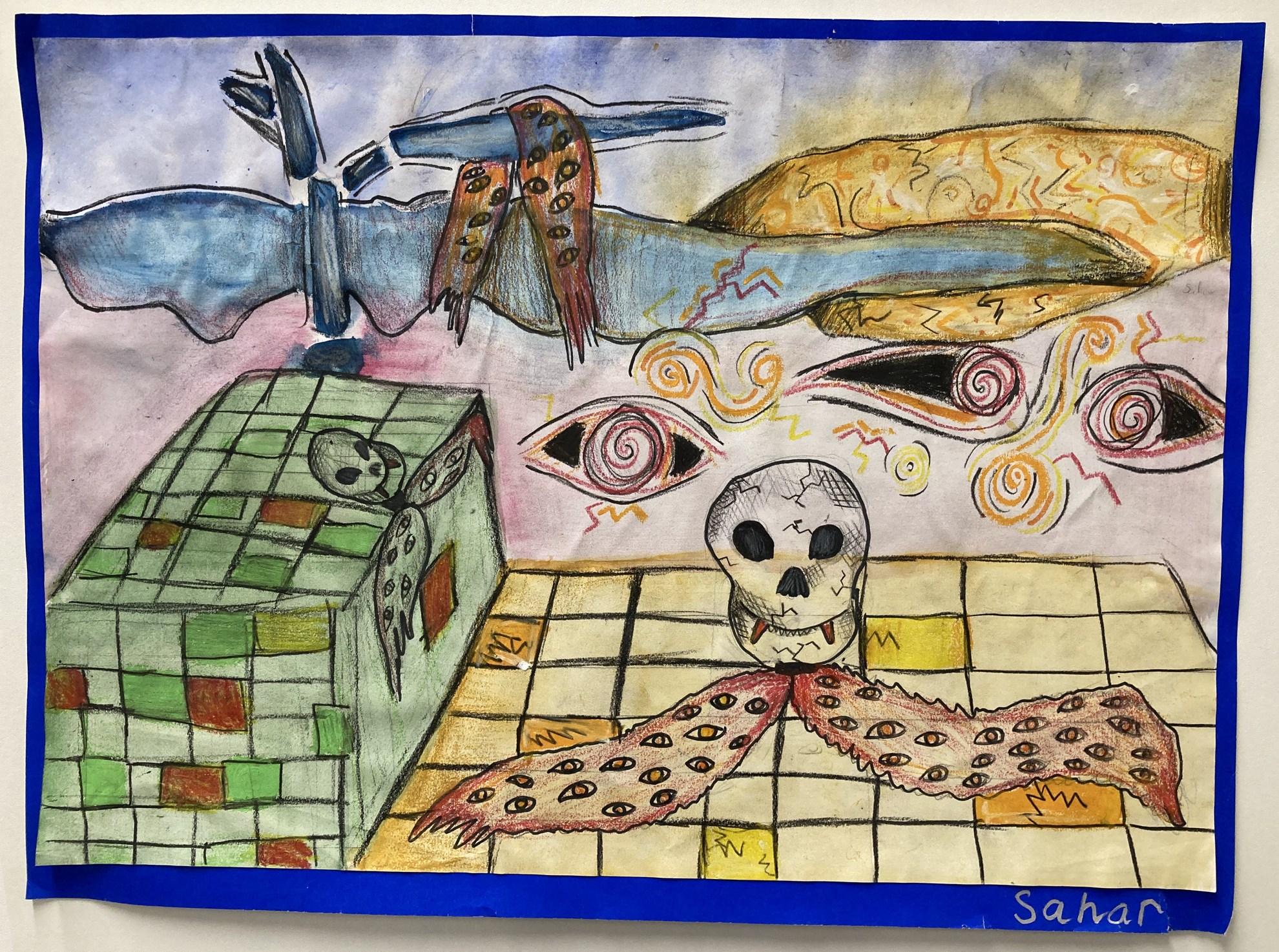
Sahar's original drawing
The third series consists in
- Isle of the Dead by Arnold Böcklin
- The Hands Resist Him by Bill Stoneham
- An untitled child drawing texture taken from MyHouse.wad
- The Scream by Edvard Munch
Between the lines, the associated quote tells about dreams of death, an unsettling statement in a child's room.

An Excursion to Carcosa, 2023
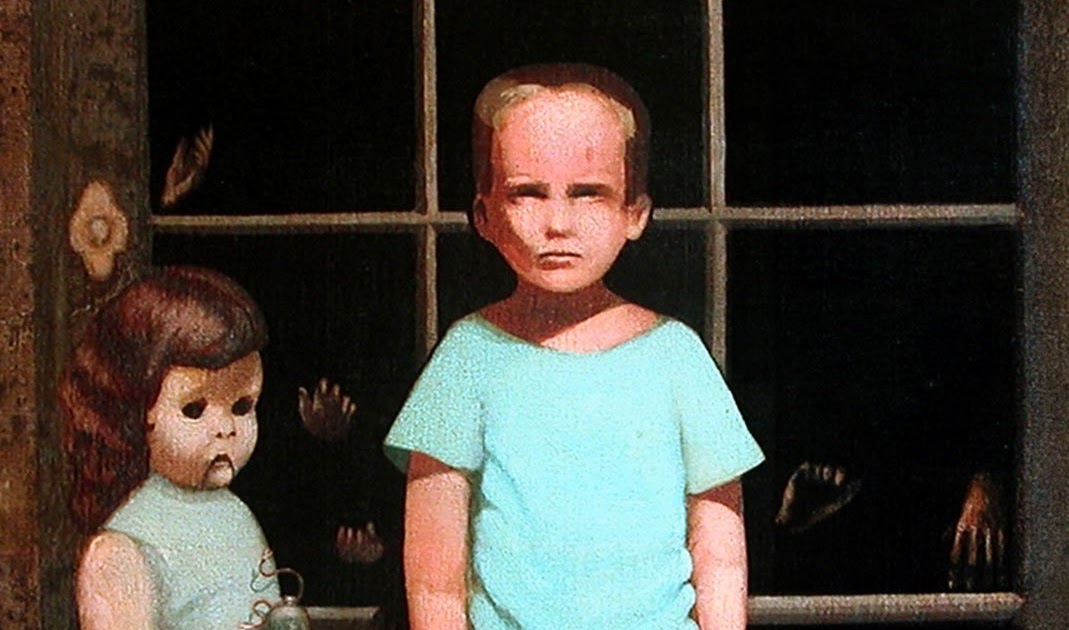
Hands at the window pane emerging from the dark: memories of frightened hours spent in the cave with no light?
The Scream mentions how the ranger's dad used to lock the scared boy in the basement, confirming the suspicion about an abused childhood.
While the carpet is not an artwork strictly speaking, it's no coincidence that it's precisely the one seen in the Backrooms series. Another hint that below the visible reality there is (or was) something darker.
Now the journey has become as deep and scary as it could be, and the hope of going up back to the light of sun is bound to what's hidden in the chest (and to the exit portal whose access is triggered by the magnet device close by).
Mapping tricks
The map is full of tricks and novelties contributing to its original atmosphere. Most of them are bound to new features added to Re:Mobilize along the way.-
Backtracking and visiting places several times is obviously a thing in Persistence of Memory, and it's not uncommon that from one visit to the next, settings have changed dramatically: a quite empty teleporter closet is now a wine cellar full of barrels, an openwork wall has turned into a door, a beautiful forest has completely withered, etc. These effects don't rely as much on stealth teleportation as you may expect. Duplicating places is something I avoided at maximum, to save me from having to maintain several instances in parallel and concerning about keeping them aligned in terms of brushwork, items and lighting.
Instead I leveraged the somewhat anecdotal func_togglewall to enhance it into one of the most powerful entities in Re:Mobilize's toolbox. This invisible blocker wall can be toggled on and off, but when I looked at how it's implemented I realized it's not so much a matter of being on or off but rather here or away. Indeed, when toggled "off", this entity has in fact its origin moved by 8000 units along each of the x y z axis, so that it still exist untouched, but moved out of the playable area. I edited it so that now it's able to bring all its targets with it: that's how fully functional doors, buttons, breakbles, etc., while natively devoid of any such toggle behavior, can now be instantly brought into/off the playable area. Constantly changing environments then become a child's play. - The impossible corridor where the cup lies is an elaborated variant of this principle. The door opens onto a long corridor, yet this door is against a wall with nothing behind. How can that be? A careful sync allows the corridor to be toggled on when the door opens and toggled off when it closes.
- Most people would certainly not realize how the silver key closet opening is unusual, but if you pay attention the rotating panels first rotate around their center of gravity to move from arrow to key pattern, then in a second move they rotate around a side hinge at the junction with the wall. Rotating entities are obviously not part of Quake's core DNA (probably why I enjoy them so much!), but rotating entities with a dynamically changing rotation axis are simply impossible at all. The visual trick suggesting it could be otherwise actually revolves around successive entities taking over. At the moment the first one has achieved its rotation, it's killtargeted and replaced by another one looking the same and standing at the same position, starting to rotate right away along its own (different) axis. The outcome looks so natural that you may likely not even notice something unusual is going on, but there's actually a whole pretty complex setup behind.
- The looking glass corridor is important storywise, as it leads to a whole new part of the map and also unfolds things in a whole new direction. So it had to feel special. It's ridiculously long to spatially express the symbolic depth of the passage, and the way of moving inside is uncanny and jerky, as a series of zooming shots. I'm really happy with the effect. It revolves around successive close teleportations, and for that reason some players have been able to accidentally telefrag the monster chasing them across the corridor. Lucky move!
- To date Re:Mobilize is not yet equipped with moving liquids, so for water changing into slime or blood I resorted to an invisible water brush staying there all the time, and a switchable illusionary entity carrying on the desired texture. A trigger_hurt toggles on when water becomes slime.
- The MyHouse door's appearance on Sahar's drawing is achieved by a series of rotating slices. Once all of them have rotated to form a door, they are killtarget to leave the place to an actual rotating door made of one single brush, showing up at the same place with the same texture and lighting, so that it's visually seamless.
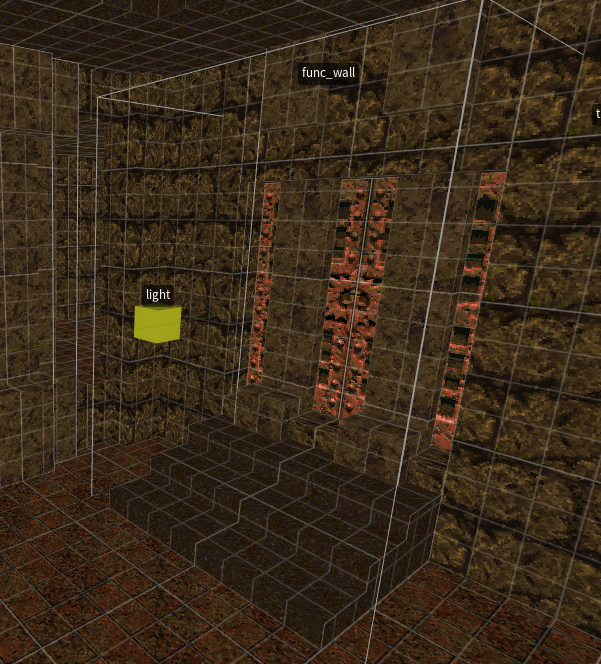
Columns and door occupying the same place, yet not at the same time.
Samey places
It's hopefully obvious for most players: the map's storytelling is supported by the endless recreation of the same place again and again, offering new and more and more bizarre variants of well-known locations, just like in MyHouse.wad.The base map by Tim Willits is featured in three versions:
- The vanilla one, with very minor variations: the FOOL panel, no grim imagery to save that for later when/if the boy is killed, and the changing teleporter closet.
- Its re:mobilized version: mostly still the same map, but now equipped with wiremeshes, trampolines and lighpanels. The big trampoline downstairs presages the endless pit in the mirror world, the MAGICIAN altar has made its appearance, the silver key closet too, etc. The map has definitely become a more complex and actual exploration and puzzle space, unlike the previous version which was more a mild introduction of sorts, and will never be returned to.
- The mirror world, as this name suggests, has its brushwork mirrored compared to the first two versions. Its texturing is completely different, inspired by the Carcosa theme I have started developing for my previous project An Excursion to Carcosa. The inverted layout, unusual texturing and disturbing paintings are there to add to the player's confusion and trigger a new mindset, as the adventure takes a new direction.
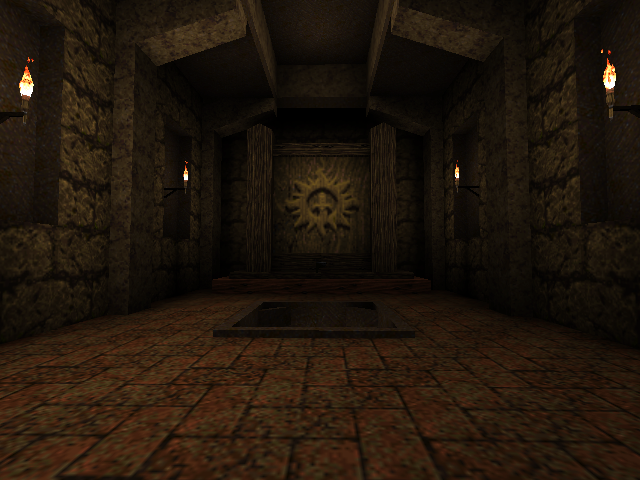
The room with a hole in the floor…
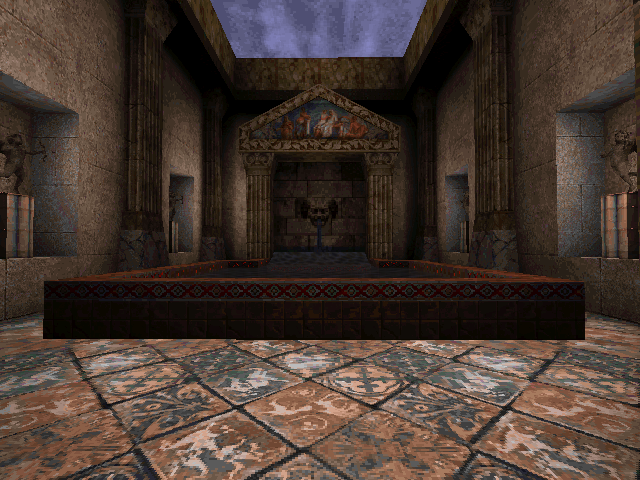
… and one of its variants.
- Vanilla, with torture side panels turned into neutral panels, and main panel turned into the title of the map.
- Vanilla (drunk): the sundagger pattern on the main panel is bigger and the title of the map has vanished.
- Re:Mobilized (nice version), with a ceiling wiremesh and lightpanel, a silver key closet, stainglass side panels and still the big sundagger main panel.
- Re:Mobilized (grim version), with Tim Willits' original torture side panels and skinned faces main panel.
- Carcosa (nice version), with tarot side panels following the player's progression on the items quest, knight armors, and the main panel featuring a dramatic medieval battle (the painting by Piotr Arendzikowski calls Grunwald 1410 and was already featured in Carcosa's forge).
- Carcosa (grim version), with the Arendzikowski's "nice King in Yellow" turned into a very ominous figure whose heart is pierced, which totally makes sense (also a mural returning from An Excursion to Carcosa, whose author is unfortunately unkown).
- Pool temple (nice version), with side panels now alcoves hosting docjr5's Cupid statues made for Carcosa at the time. The main panel has become a fountain framed by columns and a classical pediment. The hole in the ground opens onto an underwater shaft and the place contains a basin with mosaics..
- Pool temple (grim version): variant where the water changed to blood (its gurgling is lower pitch than the water's one), and the Cupids to screaming decapitated heads of the ranger. Just as the "King in Yellow" with a pierced heart, it all hints at the ranger not doing terrible things to anybody else than himself (and ultimately by extension his own team, as seen in the very last scene).
- Slipgate room: this place is seen only in the bad ending's end cinematic. The texturing is base-themed. Where the main panel was is now a big slipgate machinery. The side panels are computer-like with lights, and the hole in the floor has been replaced by the slipgate landing pod (still a threshold to/from another place, but in another way).
As said in a previous section, the vaulted area and the Backrooms are also a variant of each other: same layout, same proportions (except for lowered ceilings in the Backrooms), which allows smooth teleportations from here to there or the other way around.
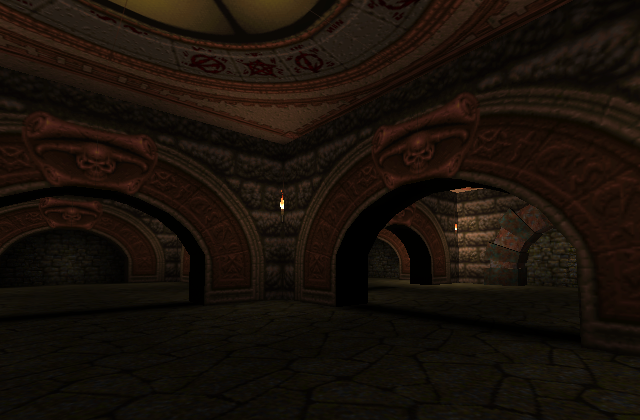
From here…
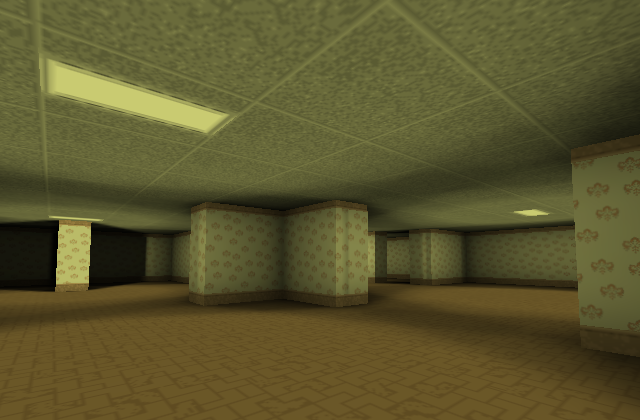
… to there.
Where does reality stops? Where does it start? Aren't our lives mere illusions?
Aren't we shadows trying to keep a cohesive continuity of self by the grace of the fragile persistence of memory…?

 Inky's Hexen II Mapping Corner...
Inky's Hexen II Mapping Corner...